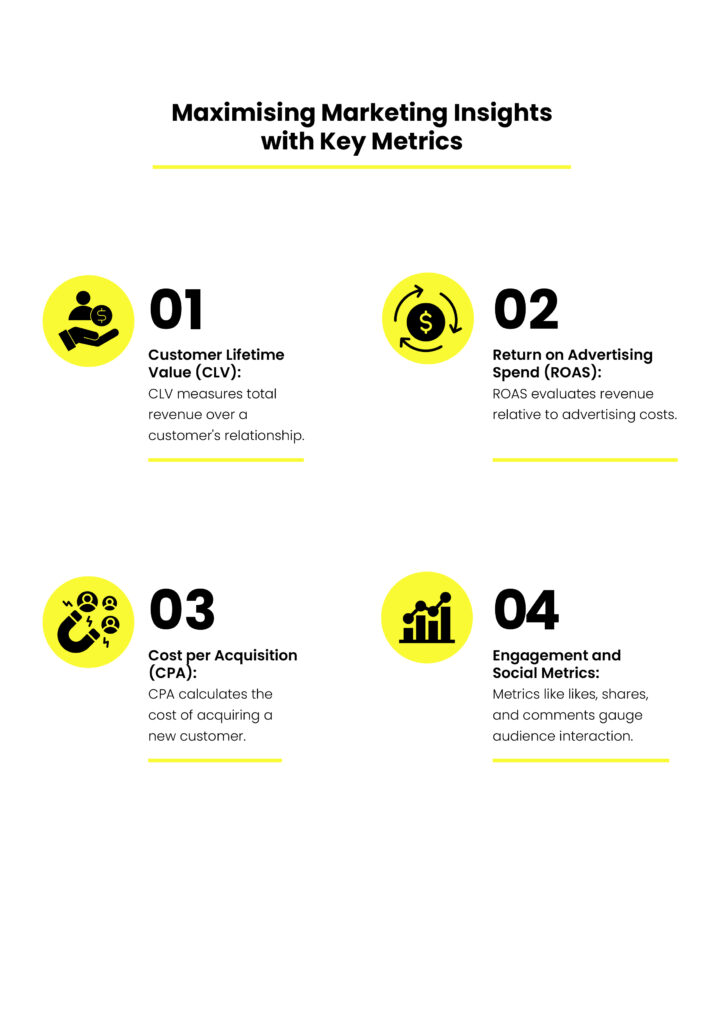Where KPIs for ROI have many identities, tracking a few emergent indicators is useful for a marketer’s evaluation arsenal. By 2024, it is safe to say that there is a metric to measure every stage of the advertising funnel, giving ROI a capacity of full throttle. In simple terms, ROI metrics are here to stay with the latest KPI differentiators in the mix.
The metrics evolution has undergone significant changes, with a shift towards prime analysis focusing on awareness and engagement. Traditional metrics have evolved into hyper-personalised segments, emphasising a user-centric approach with a focus on accessibility and timeliness. Enter ROI tracking’s vital role where we submerge in an interconnected metric population that aims to cohesively map and conclude on the best possible return on investment, catalysing effective marketing strategies and campaign outcomes.
In this blog, we will provide an overview of the latest ROI metrics which are dominating the field as of 2024, leaving like-minded business individuals on the threshold of the marketing KPI revolution.
Understanding ROI Metrics
ROI, often considered the holy grail of digital marketing metrics, measures the profitability of a marketing campaign relative to its cost. It’s calculated by dividing the net profit generated from the campaign by the total cost of the campaign and expressing it as a percentage. Key components of ROI include revenue generated, expenses incurred, and the duration of the campaign.
Shift to Advanced Metrics
When it comes to measuring marketing success, traditional ROI metrics have long been the go-to, focusing predominantly on financial returns. However, in today’s dynamic landscape, advanced metrics are increasingly gaining prominence, offering a more comprehensive view of marketing performance.
- Traditional vs. Advanced: While traditional ROI metrics focus primarily on financial returns, advanced metrics delve deeper into various aspects of marketing performance, such as customer lifetime value (CLV), return on advertising spend (ROAS), and cost per acquisition (CPA).
- Modern Necessities: In today’s digital landscape, where customer journeys are complex and multifaceted, modern marketers rely on advanced metrics to gain deeper insights into campaign performance, audience behaviour, and overall marketing effectiveness.
Emerging 2024 Metrics

As businesses strive to understand the long-term value of their customers, metrics like customer lifetime value (CLV) have become invaluable, offering insights into revenue potential over time, and the implications of relevant KPIs.
- CLV, ROAS, CPA: Customer lifetime value (CLV) measures the total revenue a business can expect from a single customer throughout their relationship. Return on advertising spend (ROAS) evaluates the revenue generated from advertising relative to the cost of the ad campaign. Cost per acquisition (CPA) measures the expenses associated with acquiring a new customer.
- Engagement and Social Metrics: In addition to financial metrics, metrics related to engagement and social media performance, such as likes, shares, comments, and click-through rates, are gaining prominence in 2024. These metrics provide insights into brand visibility, audience engagement, and content effectiveness across various digital platforms.
Industry Benchmarks
Understanding industry benchmarks allows businesses to gauge their performance relative to competitors and identify areas for improvement. Sector averages provide benchmarks for key metrics such as ROI, CLV, and engagement rates, helping businesses set realistic goals and track progress. In 2024, trends indicate a shift towards personalised and data-driven marketing strategies, with a focus on enhancing customer experiences and maximising ROI.
Influential Factors
To succinctly portray that your advertising efforts are effective, common threads in UX design, content quality and touchpoint attribution emerge for the cause, accurately elaborating their fruitful functions.
- UX, Content Quality: User experience (UX) and content quality are significant factors influencing digital marketing success. A seamless and intuitive user experience across digital touchpoints enhances engagement and conversion rates. High-quality content that resonates with the target audience drives brand affinity and loyalty.
- Attribution Challenges: Attribution, or accurately attributing conversions to specific marketing channels or touchpoints, remains a challenge for marketers in 2024. With the proliferation of digital channels and complex customer journeys, determining the true impact of each marketing effort requires sophisticated attribution models and data analysis techniques.
Maximising ROI Strategies
The important tenet to emphasise is data abound where software algorithms take the numeric journey to new heights. Brand equity cannot be overstated across platforms where automation ensures a deliberate inclination to hyper-personalising the buyer’s journey through a holistic perspective.
- Data-Driven Decisions: Data-driven decision-making involves leveraging insights from analytics tools and customer data to inform marketing strategies and optimise campaign performance. By analysing key metrics and consumer behaviour patterns, businesses can make informed decisions and allocate resources effectively.
- Personalisation, Automation: Personalisation and automation are integral to maximising ROI under effective ROI tracking strategies. Tailoring marketing messages and offers to individual preferences and behaviours increases relevance and engagement. Automation streamlines repetitive tasks, improves efficiency, and allows marketers to focus on high-impact activities.
- Cross-Platform Integration: Ensuring a unified brand experience for consumers necessitates the integration of marketing efforts across various platforms. By synchronising messaging and content delivery across channels, businesses can maximise reach, engagement, and conversion opportunities.
In conclusion, as digital marketing metrics continue to evolve, businesses must adapt and innovate to stay ahead of the curve. Key takeaways include the importance of understanding ROI metrics, leveraging advanced metrics for deeper insights, and implementing data-driven strategies to maximise ROI. Continuous adaptation to industry trends and emerging technologies is essential for driving marketing success and achieving long-term business growth.